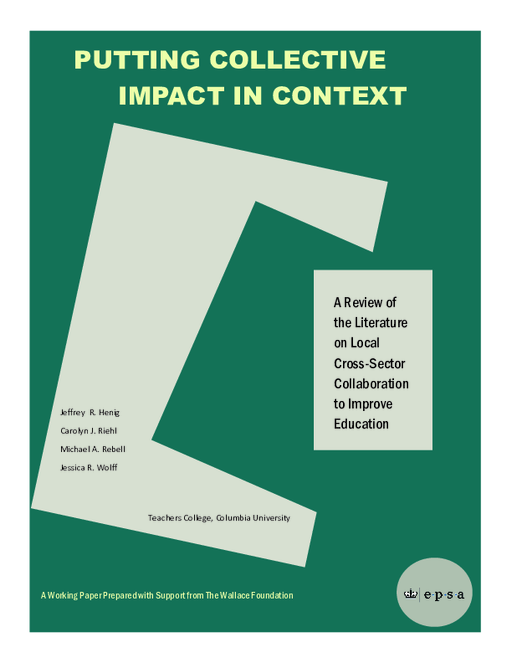Breadcrumb
- Wallace
- Reports
- Putting Collective Impact Into C...
Putting Collective Impact Into Context
A Review of the Literature on Local Cross-Sector Collaboration to Improve Education

- Author(s)
- Jeffrey Henig, Carolyn Riehl, Michael Rebell, and Jessica Wolff
- Publisher(s)
- Teachers College, Columbia University
Summary
How we did this
The goal of this paper was to provide a conceptual framing for research on collective impact in education through a review of relevant literature.
“Collective impact” is a term that describes multi-sector collaborations involving government, schools, business, universities, foundations, and nonprofits aimed at improving education.
But how much of a difference do such initiatives make?
This paper presents a critical review of relevant research conducted by a team at Teachers College to learn from efforts undertaken over the past five or so decades. The first in a series of three reports, it provides a context for later research by examining the history of previous local cross-sector initiatives, the key obstacles they have faced, and how current efforts can learn from these experiences.
Reasons to Collaborate
Researchers found several primary reasons to engage in such collaborations, such as:
- Access to resources. Organizations may not have the wherewithal to engage in efforts alone. Collaborations can also reduce the costs and risks of those programs.
- A path to success after failure. Participants might look to form collaborations if previous solo efforts didn’t succeed.
- A way to tap particular strengths. Some problems might be so complex that organizations recognize they have to work with partners with more-specialized knowledge and expertise.
Risks and Challenges
The paper suggests that it is not enough to get well-intentioned people together. Organizations must be able to address a host of potential obstacles. For example:
Political challenges can be unpredictable and complicate efforts.
While collaborations can serve to minimize risk, they can also create new problems.
Organizations might have trouble adapting their mission to the goals of the collaborative initiative.
By acknowledging it can’t succeed without partners, an organization could end up unable to justify its contributions.
A collaboration could generate costs that make the scramble for resources even more difficult.
Lessons Learned
Researchers offered preliminary suggestions for the road forward.
One is to find ways to align everyone’s interests. For example, partners could try to build relationships of mutual trust and reciprocity. That could substantially reduce the frictions that might occur.
Also important is to avoid downplaying political challenges and differences. The wider the range of groups enlisted, the more certain it will be that conflicts over values will threaten the effort from within.
Partners should focus on school-improvement efforts. If the intent is to make genuine gains in learning and educational achievement, organizations will need to address improvements in schools, as well.

Although based locally, these collaborative, cross-sector efforts are in fact rippling out widely and, in that sense, might be said to constitute a national movement.
Key Takeaways
- The first in a series of three reports, this paper examines the history of earlier local cross-sector initiatives, the key obstacles they have faced, and what current efforts can learn from those experiences.
- Multi-sector collaborations in education happen for a variety of reasons, including access to resources and a path to success after a previous failure.
- Organizations face many potential obstacles, such as political challenges, trouble adapting their mission to the goals of the collaborative initiative, and increased costs that make the scramble for resources even more difficult.
- Partners shouldn’t downplay the political challenges and differences they may face.
What We Don't Know
What does recent research show about political conflict, the dynamics of negotiation that were involved in establishing the collaborations, and the details of funding?

